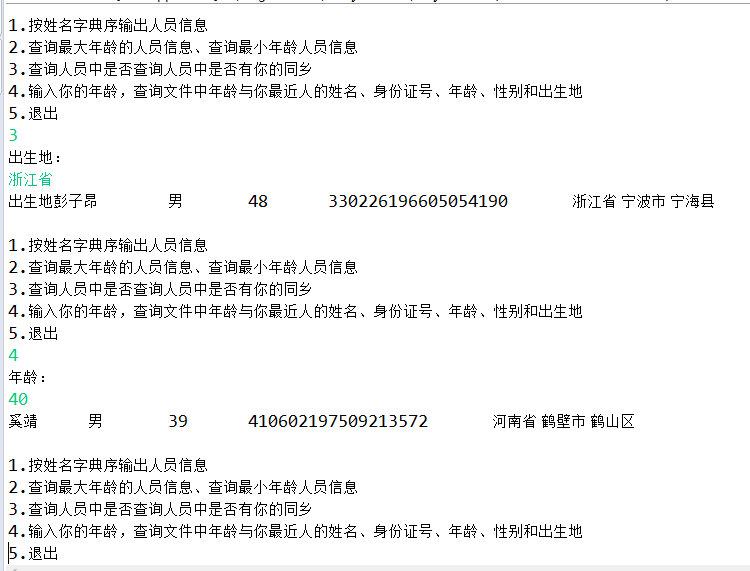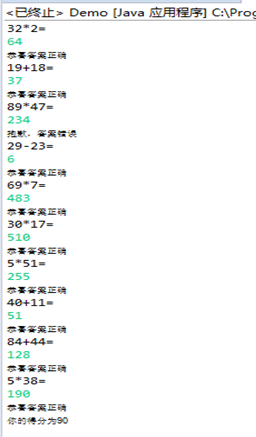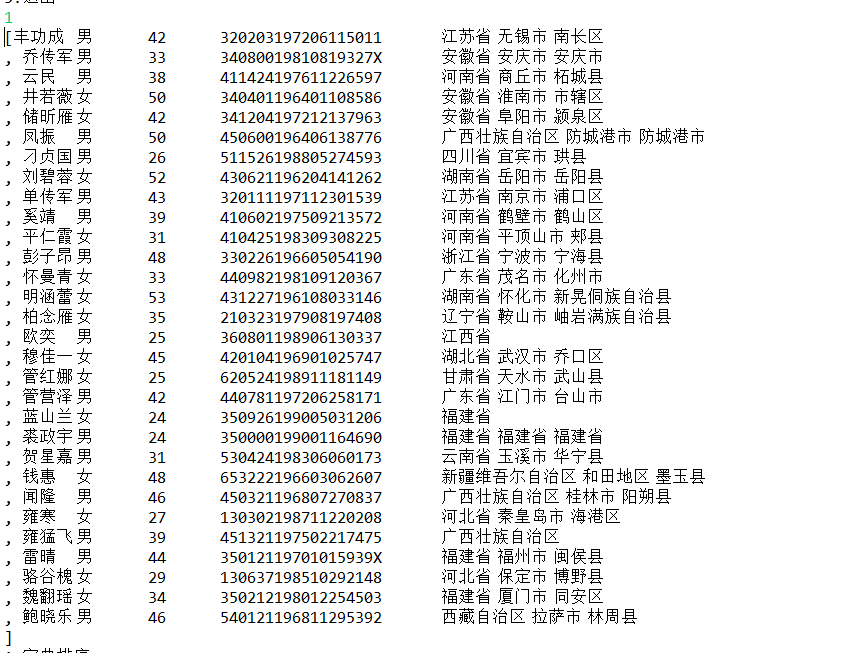狄慧201771010104《面向物件程式設計(java)》第十一週學習總結
實驗十一 集合
實驗時間 2018-11-8
1、實驗目的與要求
(1) 掌握Vetor、Stack、Hashtable三個類的用途及常用API;
(2) 瞭解java集合框架體系組成;
(3) 掌握ArrayList、LinkList兩個類的用途及常用API。
(4) 瞭解HashSet類、TreeSet類的用途及常用API。
(5)瞭解HashMap、TreeMap兩個類的用途及常用API;
(6) 結對程式設計(Pair programming)練習,體驗程式開發中的兩人合作。
2、實驗內容和步驟
實驗1: 匯入第9章示例程式,測試程式並進行程式碼註釋。
測試程式1:
l 使用JDK命令執行編輯、執行以下三個示例程式,結合執行結果理解程式;
l 掌握Vetor、Stack、Hashtable三個類的用途及常用API。
| //示例程式1 import java.util.Vector;
class Cat { private int catNumber;
Cat(int i) { catNumber = i; }
void print() { System.out.println("Cat #" + catNumber); } }
class Dog { private int dogNumber;
Dog(int i) { dogNumber = i; }
void print() { System.out.println("Dog #" + dogNumber); } }
public class CatsAndDogs { public static void main(String[] args) { Vector cats = new for (int i = 0; i < 7; i++) cats.addElement(new Cat(i)); cats.addElement(new Dog(7)); for (int i = 0; i < cats.size(); i++) ((Cat) cats.elementAt(i)).print(); } } |
| //示例程式2 import java.util.*;
public class Stacks { static String[] months = { "1", "2", "3", "4" };
public static void main(String[] args) { Stack stk = new Stack(); for (int i = 0; i < months.length; i++) stk.push(months[i]); System.out.println(stk); System.out.println("element 2=" + stk.elementAt(2)); while (!stk.empty()) System.out.println(stk.pop()); } } |
| //示例程式3 import java.util.*;
class Counter { int i = 1;
public String toString() { return Integer.toString(i); } }
public class Statistics { public static void main(String[] args) { Hashtable ht = new Hashtable(); for (int i = 0; i < 10000; i++) { Integer r = new Integer((int) (Math.random() * 20)); if (ht.containsKey(r)) ((Counter) ht.get(r)).i++; else ht.put(r, new Counter()); } System.out.println(ht); } } |
import java.util.Vector;//實現自動增長的物件陣列
class Cat {
private int catNumber;
Cat(int i) {
catNumber = i;
}
void print() {
System.out.println("Cat #" + catNumber);
}
}
class Dog {
private int dogNumber;
Dog(int i) {
dogNumber = i;
}
void print() {
System.out.println("Dog #" + dogNumber);
}
}
public class CatsAndDogs {
public static void main(String[] args) {
Vector cats = new Vector();
for (int i = 0; i < 7; i++)
cats.addElement(new Cat(i));
cats.addElement(new Dog(7));
for (int i = 0; i < cats.size(); i++)
if (cats.elementAt(i) instanceof Cat) //判斷是否能進行強制型別轉換
{
((Cat) cats.elementAt(i)).print();//能進行強制型別轉換,輸出為Cat型
} else {
((Dog) cats.elementAt(i)).print();//不能進行強制型別轉化,輸出為Dog型
}
}
}

//示例程式2 import java.util.*; public class Stacks { static String[] months = { "1", "2", "3", "4" }; public static void main(String[] args) { Stack stk = new Stack(); for (int i = 0; i < months.length; i++) stk.push(months[i]);//入棧 System.out.println(stk); System.out.println("element 2=" + stk.elementAt(2));//因為class Stack<E> extends Vector<E>所以可以使用elementAt來定位 while (!stk.empty()) System.out.println(stk.pop());//判斷如果棧不空,進行出棧操作(先進後出) } }

//示例程式3 import java.util.*; class Counter { int i = 1; public String toString() { return Integer.toString(i); } } public class Statistics { public static void main(String[] args) { Hashtable ht = new Hashtable(); for (int i = 0; i < 10000; i++) { Integer r = new Integer((int) (Math.random() * 20));//r此時為鍵值範圍(0~19) if (ht.containsKey(r)) ((Counter) ht.get(r)).i++;//得到相應的value else ht.put(r, new Counter());//如果鍵值不同則重新建立 } System.out.println(ht); } }

測試程式2:
l 使用JDK命令編輯執行ArrayListDemo和LinkedListDemo兩個程式,結合程式執行結果理解程式;
| import java.util.*;
public class ArrayListDemo { public static void main(String[] argv) { ArrayList al = new ArrayList(); // Add lots of elements to the ArrayList... al.add(new Integer(11)); al.add(new Integer(12)); al.add(new Integer(13)); al.add(new String("hello")); // First print them out using a for loop. System.out.println("Retrieving by index:"); for (int i = 0; i < al.size(); i++) { System.out.println("Element " + i + " = " + al.get(i)); } } } |
| import java.util.*; public class LinkedListDemo { public static void main(String[] argv) { LinkedList l = new LinkedList(); l.add(new Object()); l.add("Hello"); l.add("zhangsan"); ListIterator li = l.listIterator(0); while (li.hasNext()) System.out.println(li.next()); if (l.indexOf("Hello") < 0) System.err.println("Lookup does not work"); else System.err.println("Lookup works"); } } |
l 在Elipse環境下編輯執行除錯教材360頁程式9-1,結合程式執行結果理解程式;
l 掌握ArrayList、LinkList兩個類的用途及常用API。
importjava.util.*;
public
class
ArrayListDemo {
public
static
void
main(String[] argv) {
ArrayList al =
new
ArrayList();
al.add(
new
Integer(
11
));
al.add(
new
Integer(
12
));
al.add(
new
Integer(
13
));
al.add(
new
String(
"hello"
));
//包裝類即使把基本型別變成物件型別 像ArrayList這樣的集合是不能儲存基本型別的只能儲存物件 為了方便這些集合的使用所以才有了把基本型別包裝成物件型別
System.out.println(
"Retrieving by index:"
);
for
(
int
i =
0
; i < al.size(); i++)
{
System.out.println(
"Element "
+ i +
" = "
+ al.get(i));
}
}
}
import java.util.*; public class LinkedListDemo { public static void main(String[] argv) { LinkedList l = new LinkedList(); l.add(new Object()); l.add("Hello"); l.add("zhangsan"); ListIterator li = l.listIterator(0);//ListIterator<E> extends Iterator<E>迭代器 while (li.hasNext()) System.out.println(li.next()); if (l.indexOf("Hello") < 0) System.err.println("Lookup does not work"); else System.err.println("Lookup works"); } }


測試程式3:
l 執行SetDemo程式,結合執行結果理解程式;
| import java.util.*; public class SetDemo { public static void main(String[] argv) { HashSet h = new HashSet(); //也可以 Set h=new HashSet() h.add("One"); h.add("Two"); h.add("One"); // DUPLICATE h.add("Three"); Iterator it = h.iterator(); while (it.hasNext()) { System.out.println(it.next()); } } } |
l 在Elipse環境下除錯教材365頁程式9-2,結合執行結果理解程式;瞭解HashSet類的用途及常用API。
l 在Elipse環境下除錯教材367頁-368程式9-3、9-4,結合程式執行結果理解程式;瞭解TreeSet類的用途及常用API。
import java.util.HashSet; import java.util.Iterator; public class SetDemo { public static void main(String[] argv) { HashSet h = new HashSet(); //也可以 Set h=new HashSet(),Hashset實現了Set介面 h.add("One"); h.add("Two"); h.add("Four"); h.add("Three"); Iterator it = h.iterator(); while (it.hasNext()) //hasnext檢查是否還有元素進行遍歷 { System.out.println(it.next()); } } }

package treeSet; import java.util.*; /** * An item with a description and a part number. */ public class Item implements Comparable<Item>//實現比較介面 { private String description; private int partNumber; /** * Constructs an item. * * @param aDescription * the item's description * @param aPartNumber * the item's part number */ public Item(String aDescription, int aPartNumber) { description = aDescription; partNumber = aPartNumber; } /** * Gets the description of this item. * * @return the description */ public String getDescription() { return description; } public String toString() { return "[description=" + description + ", partNumber=" + partNumber + "]"; } public boolean equals(Object otherObject) { if (this == otherObject) return true; if (otherObject == null) return false; if (getClass() != otherObject.getClass()) return false; Item other = (Item) otherObject; return Objects.equals(description, other.description) && partNumber == other.partNumber; } public int hashCode() { return Objects.hash(description, partNumber); } public int compareTo(Item other) { int diff = Integer.compare(partNumber, other.partNumber); return diff != 0 ? diff : description.compareTo(other.description); } }
package treeSet; import java.util.*; /** * This program sorts a set of item by comparing their descriptions. * @version 1.12 2015-06-21 * @author Cay Horstmann */ public class TreeSetTest { public static void main(String[] args) { SortedSet<Item> parts = new TreeSet<>(); parts.add(new Item("Toaster", 1234)); parts.add(new Item("Widget", 4562)); parts.add(new Item("Modem", 9912)); System.out.println(parts); NavigableSet<Item> sortByDescription = new TreeSet<>( Comparator.comparing(Item::getDescription));//吧自定義類物件放到Treeset排序 sortByDescription.addAll(parts); System.out.println(sortByDescription); } }

測試程式4:
l 使用JDK命令執行HashMapDemo程式,結合程式執行結果理解程式;
| import java.util.*; public class HashMapDemo { public static void main(String[] argv) { HashMap h = new HashMap(); // The hash maps from company name to address. h.put("Adobe", "Mountain View, CA"); h.put("IBM", "White Plains, NY"); h.put("Sun", "Mountain View, CA"); String queryString = "Adobe"; String resultString = (String)h.get(queryString); System.out.println("They are located in: " + resultString); } } |
import java.util.*; public class HashMapDemo { public static void main(String[] argv) { HashMap h = new HashMap(); h.put("Adobe", "Mountain View, CA"); h.put("IBM", "White Plains, NY"); h.put("Sun", "Mountain View, CA"); String queryString = "IBM"; String resultString = (String) h.get(queryString);//get用來獲得value值(以鍵值為引數) System.out.println("They are located in: " + resultString); } }

l 在Elipse環境下除錯教材373頁程式9-6,結合程式執行結果理解程式;
l 瞭解HashMap、TreeMap兩個類的用途及常用API。
package map; import java.util.*; /** * This program demonstrates the use of a map with key type String and value type Employee. * @version 1.12 2015-06-21 * @author Cay Horstmann */ public class MapTest { public static void main(String[] args) { Map<String, Employee> staff = new HashMap<>(); staff.put("144-25-5464", new Employee("Amy Lee")); staff.put("567-24-2546", new Employee("Harry Hacker")); staff.put("157-62-7935", new Employee("Gary Cooper")); staff.put("456-62-5527", new Employee("Francesca Cruz")); // 列印所有條目 System.out.println(staff); // 刪除一個專案 staff.remove("567-24-2546"); // replace an entry staff.put("456-62-5527", new Employee("Francesca Miller")); // 瀏覽一個值 System.out.println(staff.get("157-62-7935")); // 迭代遍歷 staff.forEach((k, v) -> System.out.println("key=" + k + ", value=" + v)); } }

實驗2:結對程式設計練習:
l 關於結對程式設計:以下圖片是一個結對程式設計場景:兩位學習夥伴坐在一起,面對著同一臺顯示器,使用著同一鍵盤,同一個滑鼠,他們一起思考問題,一起分析問題,一起編寫程式。
l 關於結對程式設計的闡述可參見以下連結:
http://www.cnblogs.com/xinz/archive/2011/08/07/2130332.html
http://en.wikipedia.org/wiki/Pair_programming
l 對於結對程式設計中程式碼設計規範的要求參考:
http://www.cnblogs.com/xinz/archive/2011/11/20/2255971.html
以下實驗,就讓我們來體驗一下結對程式設計的魅力。
l 確定本次實驗結對程式設計合作伙伴;李瑞紅
l 各自執行合作伙伴實驗九程式設計練習1,結合使用體驗對所執行程式提出完善建議;
import java.io.BufferedReader; import java.io.File; import java.io.FileInputStream; import java.io.FileNotFoundException; import java.io.IOException; import java.io.InputStreamReader; import java.util.ArrayList; import java.util.Arrays; import java.util.Scanner; import java.util.Collections;//對集合進行排序、查詢、修改等; public class Test { private static ArrayList<Citizen> citizenlist; public static void main(String[] args) { citizenlist = new ArrayList<>(); Scanner scanner = new Scanner(System.in); File file = new File("E:/java/身份證號.txt"); //異常捕獲 try { FileInputStream fis = new FileInputStream(file); BufferedReader in = new BufferedReader(new InputStreamReader(fis)); String temp = null; while ((temp = in.readLine()) != null) { Scanner linescanner = new Scanner(temp); linescanner.useDelimiter(" "); String name = linescanner.next(); String id = linescanner.next(); String sex = linescanner.next(); String age = linescanner.next(); String birthplace = linescanner.nextLine(); Citizen citizen = new Citizen(); citizen.setName(name); citizen.setId(id); citizen.setSex(sex); // 將字串轉換成10進位制數 int ag = Integer.parseInt(age); citizen.setage(ag); citizen.setBirthplace(birthplace); citizenlist.add(citizen); } } catch (FileNotFoundException e) { System.out.println("資訊檔案找不到"); e.printStackTrace(); } catch (IOException e) { System.out.println("資訊檔案讀取錯誤"); e.printStackTrace(); } boolean isTrue = true; while (isTrue) { System.out.println("1.按姓名字典序輸出人員資訊"); System.out.println("2.查詢最大年齡的人員資訊、查詢最小年齡人員資訊"); System.out.println("3.查詢人員中是否查詢人員中是否有你的同鄉"); System.out.println("4.輸入你的年齡,查詢檔案中年齡與你最近人的姓名、身份證號、年齡、性別和出生地"); System.out.println("5.退出"); int nextInt = scanner.nextInt(); switch (nextInt) { case 1: Collections.sort(citizenlist); System.out.println(citizenlist.toString()); break; case 2: int max = 0, min = 100; int m, k1 = 0, k2 = 0; for (int i = 1; i < citizenlist.size(); i++) { m = citizenlist.get(i).getage(); if (m > max) { max = m; k1 = i; } if (m < min) { min = m; k2 = i; } } System.out.println("年齡最大:" + citizenlist.get(k1)); System.out.println("年齡最小:" + citizenlist.get(k2)); break; case 3: System.out.println("出生地:"); String find = scanner.next(); String place = find.substring(0, 3); for (int i = 0; i < citizenlist.size(); i++) { if (citizenlist.get(i).getBirthplace().substring(1, 4).equals(place)) System.out.println("出生地" + citizenlist.get(i)); } break; case 4: System.out.println("年齡:"); int yourage = scanner.nextInt(); int near = peer(yourage); int j = yourage - citizenlist.get(near).getage(); System.out.println("" + citizenlist.get(near)); break; case 5: isTrue = false; System.out.println("程式已退出!"); break; default: System.out.println("輸入有誤"); } } } public static int peer(int age) { int flag = 0; int min = 53, j = 0; for (int i = 0; i < citizenlist.size(); i++) { j = citizenlist.get(i).getage() - age; if (j < 0) j = -j; if (j < min) { min = j; flag = i; } } return flag; } }
public class Citizen implements Comparable<Citizen> { private String name; private String id; private String sex; private int age; private String birthplace; public String getName() { return name; } public void setName(String name) { this.name = name; } public String getId() { return id; } public void setId(String id) { this.id = id; } public String getSex() { return sex; } public void setSex(String sex) { this.sex = sex; } public int getage() { return age; } public void setage(int age) { this.age = age; } public String getBirthplace() { return birthplace; } public void setBirthplace(String birthplace) { this.birthplace = birthplace; } public int compareTo(Citizen other) { return this.name.compareTo(other.getName()); } public String toString() { return name + "\t" + sex + "\t" + age + "\t" + id + "\t" + birthplace + "\n"; } }

l 各自執行合作伙伴實驗十程式設計練習2,結合使用體驗對所執行程式提出完善建議;
import java.io.FileNotFoundException; import java.io.PrintWriter; import java.util.Scanner; /* * 該程式用來隨機生成0到100以內的加減乘除題 */ public class Demo { public static void main(String[] args) { // 使用者的答案要從鍵盤輸入,因此需要一個鍵盤輸入流 Scanner in = new Scanner(System.in); Counter counter = new Counter(); PrintWriter out = null; try { out = new PrintWriter("text.txt"); } catch (FileNotFoundException e) { // TODO Auto-generated catch block e.printStackTrace(); } // 定義一個變數用來統計得分 int sum = 0; int k = 0; // 通過迴圈生成10道題 for (int i = 0; i < 10; i++) { // 隨機生成兩個100以內的隨機數作加減乘除 int a = (int) Math.round(Math.random() * 100); int b = (int) Math.round(Math.random() * 100); int d = (int) Math.round(Math.random() * 3); switch (d) { case 0: if (a % b == 0) { System.out.println(a + "/" + b + "="); break; } int c = in.nextInt(); out.println(a + "/" + b + "="+c); case 1: System.out.println(a + "*" + b + "="); int c1 = in.nextInt(); out.println(a + "*" + b + "="+c1); break; case 2: System.out.println(a + "+" + b + "="); int c2 = in.nextInt(); out.println(a + "+" + b + "="+c2); break; case 3: if (a > b) { System.out.println(a + "-" + b + "="); break; } int c3 = in.nextInt(); out.println(a + "-" + b + "="+c3); } // 定義一個整數用來接收使用者輸入的答案 double c = in.nextDouble(); // 判斷使用者輸入的答案是否正確,正確給10分,錯誤不給分 if (c == a / b | c == a * b | c == a + b | c == a - b) { sum += 10; System.out.println("恭喜答案正確"); } else { System.out.println("抱歉,答案錯誤"); } out.println(a + "/" + b + "=" + c); out.println(a + "*" + b + "=" + c); out.println(a + "+" + b + "=" + c); out.println(a + "-" + b + "=" + c); } // 輸出使用者的成績 System.out.println("你的得分為" + sum); out.println("成績:" + sum); out.close(); } }
public class Counter { private int a; private int b; public int add(int a, int b) { return a + b; } public int reduce(int a, int b) { return a - b; } public int multiplication(int a, int b) { return a * b; } public int division(int a, int b) { if (b != 0) return a / b; else return 0; } }

l 採用結對程式設計方式,與學習夥伴合作完成實驗九程式設計練習1;
import java.io.BufferedReader; import java.io.File; import java.io.FileInputStream; import java.io.FileNotFoundException; import java.io.IOException; import java.io.InputStreamReader; import java.util.ArrayList; import java.util.Arrays; import java.util.Collections; import java.util.Scanner; public class A{ private static ArrayList<Test> studentlist; public static void main(String[] args) { studentlist = new ArrayList<>(); Scanner scanner = new Scanner(System.in); File file = new File("D:\\身份證號.txt"); try { FileInputStream fis = new FileInputStream(file); BufferedReader in = new BufferedReader(new InputStreamReader(fis)); String temp = null; while ((temp = in.readLine()) != null) { Scanner linescanner = new Scanner(temp); linescanner.useDelimiter(" "); String name = linescanner.next(); String number = linescanner.next(); String sex = linescanner.next(); String age = linescanner.next(); String province =linescanner.nextLine(); Test student = new Test(); student.setName(name); student.setnumber(number); student.setsex(sex); int a = Integer.parseInt(age); student.setage(a); student.setprovince(province); studentlist.add(student); } } catch (FileNotFoundException e) { System.out.println("學生資訊檔案找不到"); e.printStackTrace(); } catch (IOException e) { System.out.println("學生資訊檔案讀取錯誤"); e.printStackTrace(); } boolean isTrue = true; while (isTrue) { System.out.println("1:字典排序"); System.out.println("2:輸出年齡最大和年齡最小的人"); System.out.println("3:尋找老鄉"); System.out.println("4:尋找年齡相近的人"); System.out.println("5:退出"); String m = scanner.next(); switch (m) { case "1": Collections.sort(studentlist); System.out.println(studentlist.toString()); break; case "2": int max=0,min=100; int j,k1 = 0,k2=0; for(int i=1;i<studentlist.size();i++) { j=studentlist.get(i).getage(); if(j>max) { max=j; k1=i; } if(j<min) { min=j; k2=i; } } System.out.println("年齡最大:"+studentlist.get(k1)); System.out.println("年齡最小:"+studentlist.get(k2)); break; case "3": System.out.println("province?"); String find = scanner.next(); String place=find.substring(0,3); for (int i = 0; i <studentlist.size(); i++) { if(studentlist.get(i).getprovince().substring(1,4).equals(place)) System.out.println("province"+studentlist.get(i)); } break; case "4": System.out.println("年齡:"); int yourage = scanner.nextInt(); int near=agematched(yourage); int value=yourage-studentlist.get(near).getage(); System.out.println(""+studentlist.get(near)); break; case "5": isTrue = false; System.out.println("退出程式!"); break; default: System.out.println("輸入有誤"); } } } public static int agematched(int age) { int j=0,min=53,value=0,k=0; for (int i = 0; i < studentlist.size(); i++) { value=studentlist.get(i).getage()-age; if(value<0) value=-value; if (value<min) { min=value; k=i; } } return k; } }
public class Test implements Comparable<Test> { private String name; private String number ; private String sex ; private int age; private String province; public String getName() { return name; } public void setName(String name) { this.name = name; } public String getnumber() { return number; } public void setnumber(String number) { this.number = number; } public String getsex() { return sex ; } public void setsex(String sex ) { this.sex =sex ; } public int getage() { return age; } public void setage(int age) { this.age= age; } public String getprovince() { return province; } public void setprovince(String province) { this.province=province ; } public int compareTo(Test o) { return this.name.compareTo(o.getName()); } public String toString() { return name+"\t"+sex+"\t"+age+"\t"+number+"\t"+province+"\n"; } }

l 採用結對程式設計方式,與學習夥伴合作完成實驗十程式設計練習2。
package fghjg; import java.util.Random; import java.util.Scanner; import java.io.FileNotFoundException; import java.io.PrintWriter; public class Main{ public static void main(String[] args) { yunsuan counter=new yunsuan();//與其它類建立聯絡 PrintWriter out=null; try { out=new PrintWriter("D:/text.txt");//將檔案裡的內容讀入到D盤名叫text的檔案中 }catch(FileNotFoundException e) { System.out.println("檔案找不到"); e.printStackTrace(); } int sum=0; for(int i=0;i<10;i++) { i
